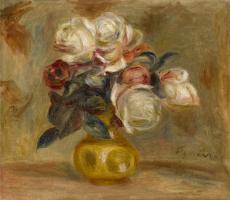


Renoir painted flowers his entire life. The first dated painting we know of his is an assemblage of flowers dated to 1858 (private collection). The subject of the last canvas he worked on, a few hours before his death, according to his son Jean, was anemones. Barely conscious, he murmured: ‘I think I’m beginning to understand something.’ Whether as a novice or an accomplished painter, Renoir considered still lifes with flowers the painter’s perfect exercise. As he told his friend and biographer, Georges Rivière: ‘Painting flowers rests my mind. It’s not as mentally demanding as when I’m face to face with a model. When I paint flowers, I lay on tones, I try out values boldly, without worrying about losing a canvas. I wouldn’t dare do that with a figure, for fear that I would ruin it. And the experience I gain from these attempts, I then apply to my paintings’.
After1900, as he grew older and became handicapped, Renoir, often confined to a wheelchair, chose more and more to paint on a loose piece of canvas temporarily pinned to a rigid support. By often combining unrelated subjects on the same canvas, he was able to paint a large quantity of studies, many of which were of flowers. These were often simple, coloured pochades, like so many preparatory exercises for more ambitious compositions. Roses Blanches probably belongs to this group, and we can see, from close observation of the edges, that it was painted on a loose piece of canvas and was then fixed into a classic wooden stretcher. Unlike the majority of contemporary works by Renoir, which are rarely dated with precision, this particular still life is generally thought to have been painted in Cagnes-sur-Mer, in 1907.
Against an abstract background, animated by vague motifs outlined by rapid brushstrokes of warm hues that barely cover the canvas (the weave of which remains visible), Renoir placed a ceramic, ochre-coloured pot full of roses. This unpretentious vase, found also in several other compositions, has a rather original shape, with hollows impressed on its belly. The plane of the table upon which the vase stands is only suggested by its being one tone darker, suggesting the shadow cast by the vase. The flowers, with their fleshy heads and their slightly open petals, have been arranged without any particular forethought, together with a branch of foliage – a country bouquet that could have come from the garden at Les Collettes. With a remarkable economy of means, with diluted tones which melt into each other, with a few brushstrokes of oil charged with white, and with carmine enhancing the ensemble, Renoir gave body to his subject, from a minimal drawing sketched completely by brush.
He found work as a porcelain painter at age 13. In 1862, he began studying in the studio of Charles Gleyre, where he met Claude Monet, Frédéric Bazille and Alfred Sisley, with all of whom he went on to lead the Impressionist movement. He is known for his portraits, especially depictions of children, his sensual nudes, floral still lifes and his depictions of modern life, in which each figure preserves their individuality. He experimented with new techniques and styles throughout his career and was the first Impressionist to shift away from the group’s main direction. Influences on him were wide-ranging, from Raphael, Velázquez and Rubens to Rococo painters, Ingres and his own contemporaries. Despite the crippling rheumatism of his later years, he painted until the last hours of his life.